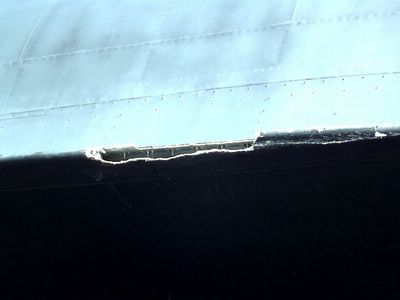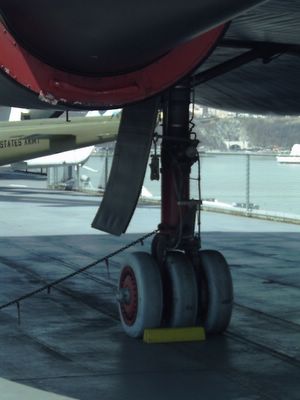CIA Article #122 (USAF tail number 60-6925) was an important part of the Cold War. She was part of a program that no one even knew about until some of the information filtered out during the late 1980's. OXCART, which was the program that created the A-12, was started by the CIA in the late 1950's to succeed the U-2 AQUATONE program. Even before the U-2 was shot down over Russia on May 1, 1960, the A-12 Blackbird was already being conceived. Her history includes being the first Mach 3 aircraft the world had seen, albeit not everyone knew about her, not even Congress in those days. To this day, the A-12 Blackbird is still the fastest aircraft on earth.
#122 is the second of the A-12s to be created by Kelly Johnson of the Lockheed Skunk Works. All of the 13 A-12s that were manufactured were actually jigged by hand. What that means is that they were hand built, not done the usual production line method. Even if you look at A-12s today, you can see that the rivet holes are not mass produced. What makes 122 unusual is that she was the A-12 that received many modifications directly from her pilots. A-12 pilots were relied on to give their ideas regarding cockpit layout, and anything else that they thought would inprove the aircraft. #122 was the flight test vehicle for the rest of the A-12's. Her construction contained composite materials that were used on her rudders. Some of the other
A-12's received titanium rudders. The spike assembly for #122 consists of titanium alloy substructure, with exterior surfaces and some of the internail componenets made of silicone-asbestos-reinforced plastic composite material. Her cockpit was configured to be what the next A-12 upgrade would have looked like had the program not been cancelled.
To give you an idea of just how advanced the A-12 was, the A-12 carried the unique "BirdWatcher" system. This allowed ground handlers to be in contact with the aircraft's system without transmission from the pilot, thereby keeping radio silence so crucial in reconnissance missions. "Birdwatcher" utilized an HF transmitter. This monitored not only the aircraft systems but equipment functions, too. The "Birdwatcher" keyed and modulated the HF tramsitter with a coded signal. The coded signal was a multiplexed sample of each of the monitored items."Birdwatcher" would trigger three short, consecutive half second bursts, each separated by five seconds of silence. during this half second burst, the condition of all items monitored along with the aircraft identity would be transmitted. This is only a sample of the systems that she carried.
What all means is this: The Lockheed A-12 Blackbird is a 21st century design in aircraft that served in the 1960's,the middle 20th Century. Her unique design has not been matched. Her mission changed the outcome of the Cold War. She served in silence as did her pilots. She went out "Alone, Unarmed and Unafraid". Her pilots risked their lives not only flying at Mach 3, but flying over denied territory. An A-12 on mission would be shot at by SAM missiles and tracked on radar, but never, ever was she caught by the enemy. The A-12 always brought home the photographic reconnissance needed to protect the United States during the Cold War. The A-12 served during the Vietnam War in a program called "Black Shield" The A-12 also flew over North Korea to find the USS PUEBLO that had been captured by the North Koreans.
The Legacy of the OXCART program and the A-12 Blackbird needs to be preserved and protected. All A-12s need to stand as the sentinel of the vital Cold War and Aviation history that they created. There is no reason for #122 to rot on the deck of an aircraft carrier that has nothing to do with her history. There is no reason for #122 to suffer abuse and damage because of the political miscreants and USAF Museum panderers allow the Intrepid Museum to reneg on the loan agreements that they signed for fear of retribution. There is no reason that #122 should deteriorate past the point of restoration so that the Intrepid Museum directors, CEO's and the Fisher Family ( the Museum was started by the late Zachary Fisher) can book every Las Vegas circus act and boxing match they can find to run wheelies around historic aircraft with no thought to the signifigance of the Intrepid deck where men in WWII have died and historic aircraft stand.
Legacy means "something that is handed down from the past or a previous generation" Museum means " a building or institution where objects of artistic, historical or scientific importance are kept, studied and put on display." Somehow, both the USAF Museum and the Intrepid Museum have lost the direction of both these words. Unfortuantely, "extinct is forever" and that is what happens when a historic aircraft is left to die.
Thursday, April 07, 2005
Wednesday, April 06, 2005
Recent pictures of #122 (chine)
Recent pictures of #122 (Landing Gear)
Tuesday, April 05, 2005
What you can do
Right now the best thing everyone can do is to contact both museums. You may be asking yourself why there's a need to contact two different museums.
I didn't know until last year that all of the modern US military aircraft you see in museums actually belong to that respective service's museum and are just "on loan" to whichever museum you happen to see them at. For example, the A-7 Corsair on the Intrepid still belongs to the Naval Aviation Museum in Pensacola, Florida and the A-12 we're working to save belongs to the US Air Force Museum at Wright Patterson Air Force Base in Dayton, Ohio. While these aircraft may still belong to their service's museum, maintenance and upkeep are the duty of the museum to which they are on loan. Unfortunately, the A-12 is under the care of the USS Intrepid.
The most helpful thing anyone can do right now is to contact both of these museums and make their opinion known to those in charge. I have listed their contact information in the sidebar, but I will also post that same information at the end of this post. The Intrepid can be reached by telephone, snail mail, or email. The US Air Force Museum doesn't have an email address, but they can still be reached by phone or snail mail. No matter which method you choose to contact these institutions, every person's contact counts!
Intrepid Sea Air Space Museum
Pier 86 12th Ave and 46th St
New York, NY 10036
Phone:212 245-0072
Attn: Col Tom Tyrell USMC (Ret)
Chairman and CEO
Email: pr@intrepidmuseum.org
General Charles Metcalf (Ret)
Director USAF Museum
1100 Spaatz Street
Wright Patterson AFB, OH 45433-7102
Phone: 1-937-255-3284
I didn't know until last year that all of the modern US military aircraft you see in museums actually belong to that respective service's museum and are just "on loan" to whichever museum you happen to see them at. For example, the A-7 Corsair on the Intrepid still belongs to the Naval Aviation Museum in Pensacola, Florida and the A-12 we're working to save belongs to the US Air Force Museum at Wright Patterson Air Force Base in Dayton, Ohio. While these aircraft may still belong to their service's museum, maintenance and upkeep are the duty of the museum to which they are on loan. Unfortunately, the A-12 is under the care of the USS Intrepid.
The most helpful thing anyone can do right now is to contact both of these museums and make their opinion known to those in charge. I have listed their contact information in the sidebar, but I will also post that same information at the end of this post. The Intrepid can be reached by telephone, snail mail, or email. The US Air Force Museum doesn't have an email address, but they can still be reached by phone or snail mail. No matter which method you choose to contact these institutions, every person's contact counts!
Intrepid Sea Air Space Museum
Pier 86 12th Ave and 46th St
New York, NY 10036
Phone:212 245-0072
Attn: Col Tom Tyrell USMC (Ret)
Chairman and CEO
Email: pr@intrepidmuseum.org
General Charles Metcalf (Ret)
Director USAF Museum
1100 Spaatz Street
Wright Patterson AFB, OH 45433-7102
Phone: 1-937-255-3284
Subscribe to:
Comments (Atom)


